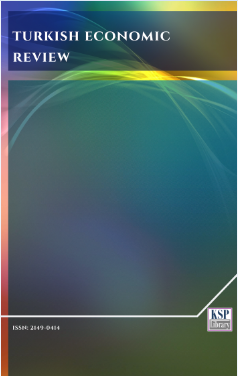The Response of Industrial Production to the Price of Oil: New Evidence for Thailand
Abstract
Abstract. This paper examines the oil price-industrial production nexus in Thailand by using multivariate cointegration test. In addition, Granger causality is also used to examine the impact of oil price uncertainty on industrial production growth. The main focus of this paper is on one sector of the economy, i.e., manufacturing sector. Monthly data from 1993 to 2015 are utilized. Empirical results reveal that there is a long-run relationship between industrial production and real oil price and other variables. Industrial production adjusts rapidly to shocks to lending rate, price level and oil price. Furthermore, there exists long-run causality running from lending rate, price level and oil price to industrial production. However, industrial production growth does not respond to oil price shock and oil price uncertainty. Asymmetric and nonlinear relationship between oil price shock and industrial output growth is not found. These findings give some policy implications.
Keywords. Industrial production, Oil price shock, Oil price volatility, Cointegration, Causality.
JEL. C22, Q43.Keywords
References
Burbidge, J., & Harrison, (1984). Testing for the effects of oil price rises using autoregressions, International Economic Review, 25(2), 459-484. doi. 10.2307/2526209
Cunado, J., Jo, S., & Perez de Gracia, F. (2015). Macroeconomic impacts of oil price shocks in Asian Economies, Energy Policy, 86(C), 867-879. doi. 10.1016/j.enpol.2015.05.004
Cunado, J., & Perez de Gracia, F. (2003). Do oil price shocks matter? Evidence for some European countries, Energy Economics, 25(2), 137-154. doi. 10.1016/S0140-9883(02)00099-3
Cunado, J., & Perez de Gracia, F. (2005). Oil prices, economic activity and inflation: evidence for some Asian countries, Quarterly Review of Economics and Finance, 45(1), 65-83. doi. 10.1016/j.qref.2004.02.003
Du, L., He, Y. & Wei, D. (2010). The relationship between oil shocks and China’s macro-economy, Energy Policy, 38(8), 4142-4151. doi. 10.1016/j.enpol.2010.03.042
Federer, J. (1996). Oil price volatility and the macroeconomy, Journal of Macroeconomics, 18(1), 1-26. doi. 10.1016/S0164-0704(96)80001-2
Gadea, M. (2014). Oil price shocks and the US economy: What makes the latest oil price episode different, International Economics Letters, 3(2), 36-44.
Gosh, N., Varvanres, C., & Marle, J. (2009). The effects of oil price shocks on output, Business Economics, 44(4), 220-228. doi. 10.1057/be.2009.33
Granger, C.W.J. (1988). Causality, cointegration, and control, Journal of Economic Dynamics and Control, 12(2-3), 551-559. doi. 10.1016/0165-1889(95)00884-5
Gronwald, M. (2008). Large oil shocks and the US economy: Infrequent incidents with large effects, Energy Journal, 29(1), 151-171. doi. 10.2307/41323148
Gupta, P., & Goyal, A. (2015). Impact of oil price fluctuations on Indian economy, OPEC Energy Review, 39(2), 141-161. doi. 10.1111/opec.12046
Hamilton, J.D. (1983). Oil and the macroeconomy since World War II, Journal of Political Economy, 91(2), 228-248. doi. 10.1086/261140
Hamilton, J.D. (2011). Non-linearities and the macroeconomic effects of oil prices, Macroeconomic Dynamics, 15(S3), 364-378. doi. 10.1017/S1365100511000307
Hansen, B. (1999). Threshold effects in non-dynamic panels: Estimation, testing and inference, Econometrica, 93(2), 345-368. doi. 10.1016/S0304-4076(99)00025-1
Herera, A.M., Lugalo, L.G., & Wata, T. (2011). Oil price shocks and industrial production: Is the relationship linear?, Macroeconomic Dynamics, 15(S3), 472-449. doi. 10.1017/S1365100511000290
Hooker, M.A. (1996). What happened to the oil price-macroeconomy relationship?, Journal of Monetary Economics, 38(2), 195-213. doi. 10.1016/S0304-3932(96)01281-0
Jemenez-Rodriguez, R., & Sanchez, M. (2005). Oil price shocks and real GDP growth: Empirical evidence for some OECD countries, Applied Economics, 37(2), 201-228. doi. 10.1080/0003684042000281561
Johansen, S. (1991). Estimation and hypothesis testing for cointegration vectors in Gaussian vector autoregressive models, Econometrica, 59(6), 1151-1580. doi. 10.2307/2938278
Johansen, S., & Juselius, K. (1990). Maximum likelihood estimation and inference on cointegration with applications to the demand for money, Oxford Bulletin of Economics and Statisitics, 52(2), 169-210. doi. 10.1111/j.1468-0084.1990.mp52002003.x
Kilian, L., & Vigfusson, R.J. (2011). Nonlinearities in the oil price-output relationship, Macroeconomic Dynamics, 15(S3), 337-363. doi. 10.1017/S1365100511000186
Kim, D.H. (2012). What is an oil shock? Panel data evidence, Empirical Economics, 43(1), 121-143. doi. 10.1007/s00181-011-0459-y
Kwiatkowski, P., Phillips, P.C.B., Schmidt, P., & Shin, Y. (1992). Testing the null hypothesis of stationarity against the alternative of a unit root: how sure are we that economic time series have a unit root?, Journal of Econometrics, 54(1-3), 159-178. doi. 10.1016/0304-4076(92)90104-Y
Lee, K., Ni, S., & Ratti, R.A. (1995). Oil shocks and the macroeconomy: the role of price variability, Energy Journal, 16(4), 39-56. doi. 10.5547/ISSN0195-6574-EJ-Vol16-No4-2
MacKinnon, J.G., Haug, A.A., & Michelis, L. (1999). Numerical distribution functions of likelihood ratio tests for cointegration, Journal of Applied Econometrics, 14(5), 563-577. doi. 10.1002/(SICI)1099-1255(199909/10)14:5<563::AID-JAE530>3.0.CO;2-R
Mork, K.A. (1989). Oil and macroeconomy when prices go up and down: an extension of Hamilton’s results, Journal of Political Economy, 97(3), 740-744. doi. 10.1086/261625
Nelson, D.B. (1991). Conditional heteroskedasticity in asset returns: a new approach, Econometrica, 59(2), 347-370. doi. 10.2307/2938260
Oh, C., & Lee, K. (2004). A dynamic equilibrium of electricity consumption and GDP in Hong Kong: an empirical investigation, Energy Policy, 35(1), 51-59. doi. 10.1016/j.enpol.2006.09.018
Park, C., Chung, M., & Lee, S. (2011). The effects of oil price on regional economies with different production structures: a case study from Korea using a structural VAR model, Energy Policy, 39(12), 8185-8195. doi. 10.1016/j.enpol.2011.10.018
Rahman, S., & Serletis, A. (2011). The asymmetric effects of oil price shocks, Macroeconomic Dynamics, 15(S3), 347-471. doi. 10.1017/S1365100511000204
Wei, Y. (2013). The dynamic relationship between oil prices and the Japanese economy: a frequency domain analysis, Review of Economics and Finance, 3(2), 57-67.
DOI: http://dx.doi.org/10.1453/ter.v4i3.1320
Refbacks
- There are currently no refbacks.
.......................................................................................................................................................................................................................................................................................................................................
Turkish Economic Review - Turk. Econ. Rev. - TER - www.kspjournals.org
ISSN: 2149-0414
Editor: [email protected] Secretarial: [email protected] Istanbul - Turkey.
Copyright © KSP Library




